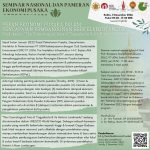Author : Laretna T. Adishakti
Paper presented in the International Conference of World Heritage Cities of Euro-Asia, Solo, 25 – 28 October 2008
Abstract:
Conservation of heritage cities has not mainly concerned with preservation of city’s historic fabrics or beautification of city center, but a more holistic approach such as interpretation of various types of nature and cultural heritages-tangible and intangible, community participation program, economic analyses and forecasting, and attracting business and social-culture activities. The goal instead of preserving the historic value is provides better quality of life. On the other hand, heritage city is confronted with various kinds of risks. For instance poverty, racial or religious conflicts, disaster (especially in the area of natural hazards), deterioration of traditional community, irresponsible community development such as tourism. In the case of natural disaster, the risk itself is not only by the disaster, but also during the stage of emergency response, recovery and the reconstruction post-disaster. Many cases show that heritage post-disaster is not the priority to be handled.
Conservation of cultural heritage of the historic city is inevitably essential to sustainable development (Williams, 2001), and many experiences exhibit that local people can play a strategic role in controlling the obligatory regeneration of their heritage environment. There is now a paradigm shift in the approach to heritage conservation where the responsibility for saving the heritage is moving from the few elite individuals (princes, priests and politicians) to general public (people) (Engelhard, 2001). However, people awareness in order to transform a conservation idea into practice requires the continued support and commitment from outsiders as well as community mediator.
The Urban Space Heritage Conception is proposed as a possible solution to the problems of heritage conservation planning today (Adishakti, 1997), which has come to the stage where people must find a way to establish the existence of various natural and tangible and intangible cultural heritage in dynamic urban settings amid the rapid growth of modernization and be prepared for various kinds of risks. Two years on going exploration of the Urban Space Heritage Conception to support the initiatives on heritage emergency response, recovery and reconstruction of Kotagede Heritage District, Yogyakarta, Indonesia post earthquake 3 will be highlighted in this paper.




